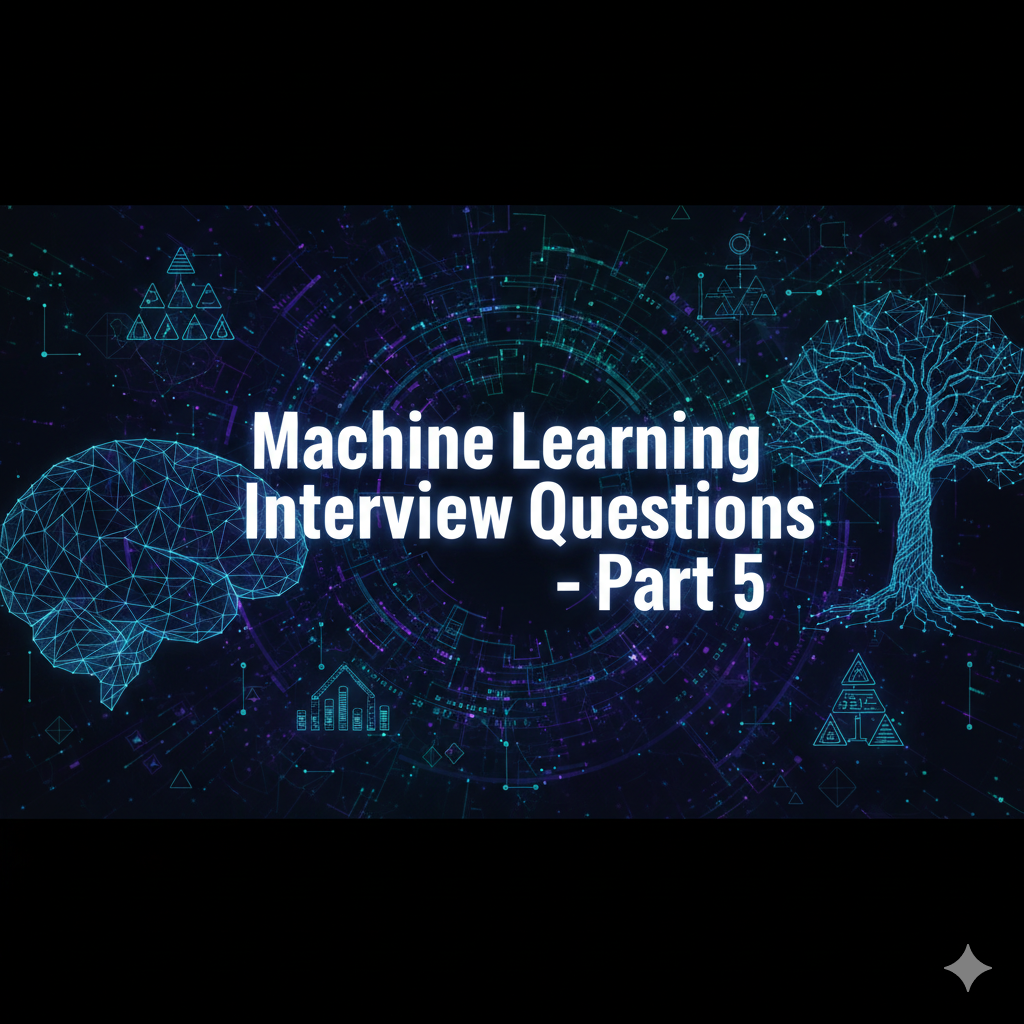Welcome to Part 5 of our Machine Learning Interview Questions Series. In this edition, we explore Responsible AI, including questions around fairness, data privacy, compliance, and model governance. These are must-know topics for data scientists and ML engineers working in finance, healthcare, edtech or any domain where machine learning impacts human lives.

As AI adoption grows, so do the expectations for ethical, explainable, and legally compliant models. These questions help you prepare for interviews where you’re expected to not only build accurate models but also responsible ones.
41. What is Responsible AI?
Responsible AI refers to the practice of designing, developing, and deploying AI systems in a way that is ethical, transparent, and accountable.
Key principles:
- Fairness: Avoid discrimination
- Transparency: Make models explainable
- Accountability: Assign responsibility for decisions
- Privacy: Protect user data
- Robustness: Ensure safety and reliability
Organizations like Google, Microsoft, and IBM have published their Responsible AI frameworks to guide ML practitioners.
42. What is model fairness in machine learning?
Fairness in ML ensures that a model’s predictions are not biased against individuals or groups based on sensitive attributes like gender, race, or age.
Common Fairness Metrics:
- Demographic parity
- Equal opportunity
- Equalized odds
- Disparate impact
Bias can originate from data, labeling, features, or model behavior, so fairness must be addressed at multiple levels.
43. How do you detect and mitigate bias in ML models?
Bias Detection Techniques:
- Compare model metrics across groups (e.g., accuracy for males vs females)
- Use visualization tools (Fairlearn, Aequitas)
- Feature importance analysis to identify indirect proxies
Mitigation Strategies:
- Pre-processing: Balance datasets or reweigh samples
- In-processing: Use fairness-constrained algorithms
- Post-processing: Adjust predictions to reduce disparity
Tools like IBM AI Fairness 360 and Fairlearn help automate bias detection and mitigation.
44. What is model explainability and why is it important?
Model explainability refers to understanding why a model made a certain prediction.
Why it matters:
- Builds trust with stakeholders
- Helps with debugging and compliance
- Required for regulated industries
Explainability Techniques:
- SHAP (Shapley Additive Explanations)
- LIME (Local Interpretable Model-agnostic Explanations)
- Partial Dependence Plots
- Counterfactual explanations
Interpretable models (e.g., decision trees, logistic regression) are often preferred in high-stakes environments.
45. What are data privacy concerns in ML?
ML models often rely on personal or sensitive data. Common privacy concerns include:
- Unintended memorization of user data
- Data leakage during feature engineering
- Inference attacks where attackers extract training data from models
Mitigation Strategies:
- Anonymization and pseudonymization
- Differential Privacy
- Federated Learning
- Data minimization
Compliance with laws like GDPR and HIPAA is critical when working with sensitive information.
46. What is Differential Privacy?
Differential privacy is a formal privacy guarantee that ensures individual data points do not significantly influence the output of an algorithm.
- Adds mathematical noise to query results
- Makes it difficult to infer whether a specific record was included
- Used by Apple, Google, and the US Census Bureau
It balances utility and privacy, especially in analytics and federated learning systems.
47. What is Federated Learning?
Federated Learning is a decentralized ML training technique where the model is trained locally on edge devices, and only model updates are shared with the central server.
Benefits:
- Enhances data privacy
- Reduces data transfer costs
- Useful for on-device personalization (e.g., Gboard, Siri)
It’s often combined with secure aggregation and differential privacy for end-to-end secure learning.
48. What is model governance?
Model governance refers to the processes and policies for managing ML models across their lifecycle.
Includes:
- Model approval workflows
- Version tracking
- Audit logs
- Access controls
- Compliance validation
Governance tools are especially important in finance, insurance and healthcare where models must meet regulatory standards (e.g., SR 11-7, EU AI Act).
49. What are the key ML compliance standards and regulations?
Here are some industry regulations you should know:
- GDPR (EU): Data protection and privacy, including Right to Explanation
- HIPAA (US): Healthcare data security and privacy
- CCPA (California): Consumer data protection
- EU AI Act (Upcoming): Risk-tiered regulation of AI systems
- SR 11-7 (US): Model risk management for banking
Compliance means models must be auditable, interpretable and documented.
50. What documentation is essential for ML models in regulated environments?
Required documentation often includes:
- Model cards: Summarize intended use, performance, and fairness
- Datasheets for datasets: Describe how and why the dataset was created
- Experiment tracking logs: Model versions, hyperparameters, metrics
- Audit trails: Who trained/deployed the model, when, and why
Frameworks like Google’s Model Cards and Data Nutrition Labels help ensure transparency and reproducibility.
Conclusion
In Part 5 of our Machine Learning Interview Questions Series, we’ve shifted the focus from accuracy and performance to ethics, fairness, compliance and accountability. These topics are no longer optional—they’re essential for building trustworthy, human-centered AI systems.
Understanding these concepts prepares you not just for technical interviews but also for leadership roles where decision-making around AI adoption, governance and risk mitigation are key.
Stay tuned for Part 6 where we’ll dive into open-source ML tooling, model registries, experiment tracking and best practices for ML collaboration in teams.
Related Read
Machine Learning Interview Questions – Part 4

2 thoughts on “Machine Learning Interview Questions – Part 5”